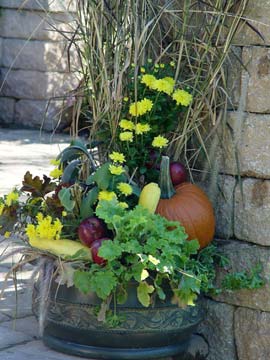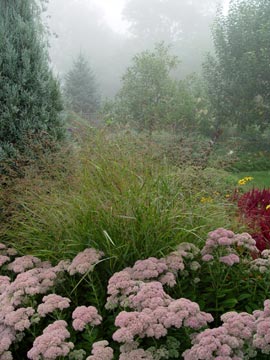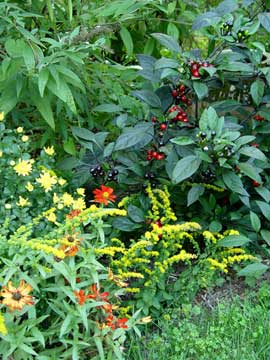Brighten the autumn landscape with a symphony of late-peaking plants
 This pot pairs a yellow mum with a sage plant, a gold-leafed coralbell and accents of grass, apples and a pumpkin to create a fall display.
This pot pairs a yellow mum with a sage plant, a gold-leafed coralbell and accents of grass, apples and a pumpkin to create a fall display.
© George Weigel
Fall can be one of the most colorful times in a home landscape. Gardeners have almost as many choices in fall-interest plants as they do in spring varieties. One difference is that autumn’s color scheme tends to run heavier in "warm" tones such as red, gold and orange than spring’s more cool-tone pink, blue and white.
The fall landscape also takes a bit more planning, especially since more people do their garden planning and planting in spring when fall peakers usually aren’t doing much to grab attention. The solution to that is 1.) think about the fall landscape when buying in the spring or 2.) go back to the garden center in fall to see what’s looking good then.
Mums are America’s long-time fall favorite since these are so colorful and so readily available… inexpensively, too. Many gardeners treat mums as "fall annuals", using them in pots until the color fades and then tossing them. Little care other than watering every day or two is all that’s needed when that’s the game plan. Mums are showy enough that they can stand alone in patio or deck pots. But they’re even more effective when paired with other fall-peakers that either contrast their form or coordinate with their colors.
 Mums are at their best when ringing the feet of a taller evergreen.
Mums are at their best when ringing the feet of a taller evergreen.
© George Weigel
Cool-season pansies are a top mum partner since they come in just about as many colors as mums, making a good match possible no matter which mum you start with. Ornamental cabbage and kale, ornamental hot peppers, herbs such as sage and golden oregano, and even groundcovers or perennials with colorful foliage (coralbells, creeping sedum and hosta, for example) all make good mum partners. Accent the pot with a few baby gourds, a dwarf grass or a berried twig or two from a nandina, viburnum or holly.
Mums also plant well in the ground, where they’re at their best lighting up a border garden or sunny foundation. They also make excellent edgings at the feet of taller evergreens. In the ground, mums return best when they’re planted early in fall, left unpruned until end of winter, and fertilized with a long-acting fertilizer, such as Natural Start by GreenView All Purpose Plant Food.
 The spiky texture and pink seed heads of this ornamental grass pair nicely with the pink flowers of sedum 'Autumn Joy' in this fall garden.
The spiky texture and pink seed heads of this ornamental grass pair nicely with the pink flowers of sedum 'Autumn Joy' in this fall garden.
© George Weigel
While mums are the best known of the fall bloomers, they’re far from the only option. Sedum, goldenrod, asters, turtlehead, liriope, leadwort and Japanese anemone are seven other perennials that bloom in early fall. Many others continue to flower or bloom for a second time in the same time frame, including catmint, lavender, many salvias, gaillardia, reblooming daylilies, reblooming iris and Russian sage. And don’t overlook dahlias as another showy flower that blooms from late summer into fall, depending on variety. Those are hardy perennials in some parts of the United States but tender tubers that must be lifted each fall and stored inside everywhere else. Fertilize dahlias twice each season with Natural Start by GreenView All Purpose Plant Food.
One way to create an effective fall display out of that group is to divide them into "warm" and "cool" color families. Warms include red, gold, orange, yellow, dark purple, burgundy and similar bright or heavily saturated colors. Red daylilies, dark-purple asters and golden goldenrod would fall into this scheme, for example. Cools include pink, blue, lavender, white and most any pastel or softly saturated color. Blue-blooming catmint, pink Japanese anemone and white turtlehead would fall into this scheme. You won’t color-clash if you stick within those two main families. Then it’s a matter of making sure you place taller plants toward the back of a garden and shorter ones toward the front. (This is where your shovel comes in handy if you guess wrong.)
 A yellow mum coordinates with the red fruits of an ornamental pepper, the golden flowers of a dwarf goldenrod and the orange-red flowers of zinnias in this fall partnership.
A yellow mum coordinates with the red fruits of an ornamental pepper, the golden flowers of a dwarf goldenrod and the orange-red flowers of zinnias in this fall partnership.
© George Weigel
A third design consideration is contrasting the form and texture of neighboring plants. A liriope with upright, spiky leaves, for example, would look better next to a rounded aster than alongside a daylily with similar strappy, spiky leaves. Besides paying attention just to flowers, consider leaf color and texture as well. An increasing number of new plants sport interesting foliage instead of plain green leaves. Still others have foliage that turns color in fall, giving opportunity to pair with a flower that blooms in a coordinating color at the same time.
Spirea Mellow Yellow®, for example, is a shrub with willowy, golden foliage that turns a rich shade of copper in fall. A line of red mums or a planting of red dahlias would make ideal bedfellows. Similarly, many ornamental grasses have mature pink or buff-colored seed heads and burgundy blade coloring in fall at a time when sedums are blooming pink and then changing to burgundy.
Finally, don’t overlook fall fruits. Many flowering shrubs produce fruit or berry clusters in autumn, opening the door to still more coordinated pairings. The metallic purple BB-sized clusters of beautyberries, for example, pair nicely with pink asters or reblooming dark-purple salvia. Or pair a golden goldenrod or reblooming yellow daylily with a winterberry holly that’s displaying fire-engine-red fruits.
If you’re missing the boat on these fall opportunities, remember, fall also happens to be a good time for planting… and in most cases, transplanting.